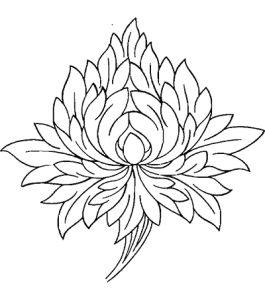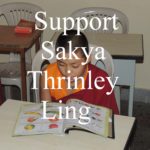The Origin of Nuns
According to the fully enlightened Buddha Shakyamuni, the only way out of the pain and confusion that we and all beings like us experience all the time, is to realize the profound truth of Dharma. Throughout the ages many people have wanted to devote their entire life to this ultimate attainment of complete realization, by joining the monastic community, an institution that traces back to the time of the Buddha himself, and which has since been a veritable pillar in the propagation of the teachings to the four corners of the world.
The acceptance of female practitioners or nuns into monasticism has had many challenges, again dating back to the very earliest years after Siddhartha became Buddha under the bodhi tree in Bodhgaya.
In the earliest times, the ordained community—the sangha—was exclusively for monks. Upon the Buddha’s return to his father’s kingdom, Kapilavastu, his maternal aunt and adoptive mother, Mahāpajāpatī Gotamī, beseeched the Buddha to be ordained as a nun so she could follow in his footsteps. The Buddha refused and it seemed that women would have been banned from the monastic tradition. Undaunted, Gotamī resolutely cut off her hair and donned the yellow robes—the marks of monasticism and requested again, through the intermediary of Ananda. The Buddha consented and she became the very first bhikṣuṇī or ordained Buddhist nun. The very first in what became a long line of many accomplished women in the monastic tradition of Buddhism.

The history of monasticism in Tibetan started in the 8th century when the great Indian saint Shantarakshita ordained the first seven Tibetan monks—as a test to see if monasticism would be able to flourish in Tibet. Among the first seven was Khon Luwang Srungwa (Nagarakshita), an ancestor of the founding father of the Sakya tradition. No ordination for women existed in Tibet until much later. The very earliest records of nuns in Tibet were found dating from the time of Rinchen Sangpo (958-1055). Further references of nuns in Tibet are found in Milarepa’s (1052-1135) songs of realization.
Perhaps the earliest known Sakya nun is Sakya Pandita’s half-sister, Zopa Ringmo. She is mentioned in the writings of Jetsun Drakpa Gyaltsen (1147-1216), one of the five founding lineage masters of Sakya.
During the time of the 31st Sakya Trizin Ti-Shri Kunga Lodro (1729-1783), four Labrangs were founded-the Zhithog Labrang, Duechoe Labrang, Lhakhang Labrang and Rinchengang Labrang. Over the years, the Rinchengang Labrang gradually transformed into a nunnery. All the famous Jetsunmas (daughters of the Khon family) such as Jetsunma Chime Tenpei Nyima, Jetsunma Tadrin Wangmo, and so on were from this nunnery.
Since then, the lineage of the Sakya nuns continues to flourish in Tibet until the 1950’s when political turmoil caused much disruption to the monasteries and nunneries in Tibet. [continue reading at Sakya Rinchen Choling].
Our activities
The nuns lead a rigorous life of study, contemplation and work as practice. Every day, the nuns start the day by performing Tara puja at 6:00AM. The student nuns then continue the rest of the day with the learning of Buddhist ritual, scriptures, English, Hindi and Tibetan.
On auspicious dates, the nuns recite special prayers. On the 14th and 29th of the Lunar calendar, the nuns perform the extensive Mahakala ritual; on the 10th and 25th of the Lunar month they celebrate the Vajrayogini tsog; on Buddha Purnima day and other special anniversary dates, the Sakya lineage prayers, sixteen Arhat puja and Guru Yoga practices are done. Additional pujas are also conducted regularly on request by devotees, the lay community and sponsors for their loved ones who may be sick, for removal of obstacles in one’s life, or for fulfilling other objectives.
The highlight of the nuns’ activities is the accumulation of 100,000 of the Twenty-one Praises to Tara during the performance of Tara pujas which spans several consecutive days of intensive marathon conducted several times a year. During every March, this special prayer activity is held specially for the benefit of the sponsors, with the vast merit accumulated dedicated to all sentient beings. To learn more about Tara and the benefits of practising Tara, click here.
In order for the nuns to continue with their lifelong devotion to the Buddha Dharma, your generosity and help is greatly needed. Please consider helping us by making a donation.
Support us
The ordained sangha is crucial in upholding the authentic teachings of the Buddha to ensure that the Buddha Dharma continue to remain with us for many generations to come. The ability for these noble sangha to carry on this meritorious work relies upon the staunch and generous support of donors. Please contribute today and donate regularly to this worthwhile cause. Each gift is deeply appreciated by the nuns and every gesture to assist the nuns continue the path of dharma for the sake of all sentient beings is of immeasurable merit and benefit.
Dana
The nuns live on simple vegetarian meals. It costs less than US$2 a day to feed, educate and pay for a nun’s living expenses, or US$700 per year; a gift of US$60 will provide for a nun for one month. Specific contributions can also be made towards the nuns’ medical fund for them to see a doctor and receive medical treatment when they fall ill, offering towards educational costs such as text purchases, teachers expenses, classroom materials, food, etc. For contribution information, please select the respective nunnery’s support page you wish to donate to.
Prayers Requests
An important part of a nun’s vocation is to conduct prayers and help those in need spiritually and in their daily lives. When sponsors send their prayer requests to Sakya nunnery together with their donation, the contribution goes towards supporting the expenses incurred by the nuns. Support the nuns’ work by sponsoring prayers and pujas. Online prayer requests to Sakya Nunnery can be made on Sachen Foundation’s website. The Sachen Foundation supports monks and nuns, Sakya nunnery is one of the institutions it supports. Go to Sachen Foundation donation page [click here], write in the notes field that the donation is for Sakya nunnery, the specific prayer requested and name of person the prayer is dedicated to, the prayer request will be transmitted to the nunnery for arrangement of the prayer.
Dedication
By this merit, may all who suffer in body or mind, experience instead a vast ocean of pure joy and happiness.
May all beings in the ten directions be happy! May they ever be free from pain. May they live in accord with the spirit of Dharma (of not harming others) and find all their hopes and aspirations fulfilled.
SARVA MANGALAM!


